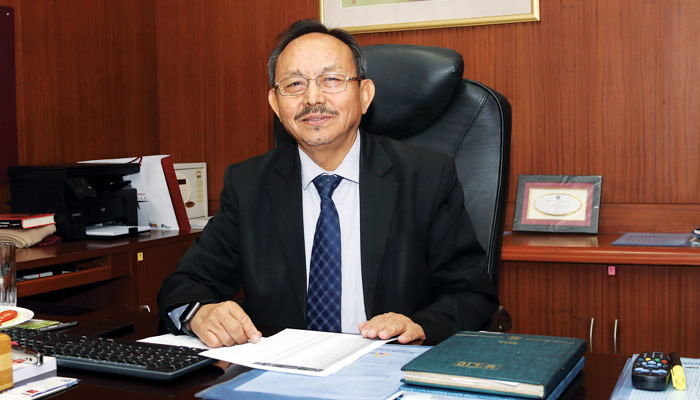LIC Mutual Fund, in the last three decades of its existence, has emerged as the most preferred investment platform. After all, the parent organization, LIC is the most reliable and trusted brand with more than 73 per cent market share in insurance sector.
Keeping the legacy intact, LIC MF team, led by Mr Dinesh Pangtey, Chief Executive Officer has devised its own unique investment strategy with a stringent credit appraisal process, high standard of financial ethics and corporate governance. It has been creating value for its investors by adopting robust and innovative investment strategies, catering to all segments of investors and providing them a superior investment experience.
When he speaks, having 35 years of experience behind his simple, humble and very genteel persona, Mr Pangtey is a delight to watch. He has vast experience across Private Equity, Life, Pension, Group Superannuation Scheme and Insurance sector. His days as CEO with the private equity division of the LIC Group are remembered for some spectacular achievements. Here Mr Dinesh Pangtey shares his views in a free-wheeling chat with Indian Economy & Market.
What are the available opportunities that you see in Mutual Fund arena in the current market conditions?
If you go by the stats, less than 1.5% of India’s population invests in MFs and number of Mutual Fund accounts is only 66 million. India’s MF Asset Under Management (AUM) is only 11% of GDP as against 101%, 76%, 65%, 59% and 57% for US, France, Canada, Brazil & UK respectively. Mutual Funds’ share in the country’s financial savings still is only about 6%. Hence, there is ample opportunity in this arena. As per AMFI’s August 2019 report, the industry has the potential to cross Rs100 trillion in AUM in the mid-twenties. While the asset management industry took almost 50 years to build the first Rs10 trillion of AUM, the next Rs10 trillion was amassed in less than five years. More importantly, Systematic Investment Plan (SIP) has grown even stronger. The industry AUM has grown by over 40% from 17.5 trillion in March 2017 to 27 trillion in December 2019. During the same period, monthly SIP contributions have almost doubled from Rs4,335 crore a month to Rs8,518 crore a month. This corroborates with LIC MFs strategy to focus more on SIPs from retail client and not restricting it only to metros or on FIIs. We have devised a strategy to increase penetration beyond metros by leveraging on our parent LIC of India’s vast network and strong brand. As per AMFI’s report, Maharashtra and New Delhi accounts for over 50% of total MF investments. We aim at penetrating beyond these saturated markets to hunt for AUM growth.
As you know, India’s growth story has taken a step back recently. In these tough times, mutual fund industry requires long term investors who are patient enough to hold onto their investment in order to ride along the growth story of India. Hence, we think, chasing for SIP investment is the right strategy. We are targeting millennials which in our view is the key target market. Around 65% of Indians are born after 1980 and that is a big number.
How has the journey been for LIC MF and what are the target plans for future?
LICMF has seen series of transition over the years. I can say confidently that now we are well placed and are poised to grow in a strong manner. We have developed a holistic approach towards AMC growth by aligning to the growth levers of industry and economy. We have realized that growth cannot be achieved in isolation. We have built our positions in debt and equity schemes taking cues from the macro numbers. We believe we are at the cusp of interest rate cycle change and have accordingly rebalanced our portfolio and we have been educating investors accordingly. Furthermore, we have come up with few new product launches to trap additional inflows. For our Equity schemes, we have been focusing on sustaining strong performance of our flagship schemes while turning around our underperforming schemes.
In my view one of the efficient ways one can differentiate in MF industry is through investor service. Hence improving TAT is our key focus area. Few of the measures taken by us to achieve this is investing heavily on technology, revamping our website to improve the user-friendly quotient, deepening our reach and touch points, to name a few.
In terms of the AUM growth, we plan to grow at a pace thrice the Industry. We are focusing on garnering investment that is consistent, sticky and predictable in nature. Thus, we are focusing more on retail penetration. The strategic acquisition of IDBI Bank/Capital by the sponsor LIC of India is going to be instrumental to achieve this objective. This association will help us leverage on IDBI’s distribution landscape for seamless penetration to tier 3 and 4 cities. Recently, we partnered with BSE STAR MF for selling our products on its platform. This will empower all our IFAs and KBPs in several ways, for instance, allowing them seamless empanelment to the esteem platform, is economical as they will get free back office services and will give them scale to expand their business.
What should be the right asset allocation strategy in the current interest rate and market scenario?
A right allocation depends less on interest rate and market conditions and more on the demography of an investor and his investment goals. Interest rates and market conditions may keep on fluctuating in the short run, but one must view financial markets as a long-term play. We believe the age of the investor and his investment goal should determine his asset allocation. For e.g. a 30-year-old investor with an investment horizon of 15 years to build his corpus should aim for higher returns in his initial years of investment, later he may gradually shift towards fixed income. Hence, we advise young investors to concentrate large portion of their investments in equity mutual fund and smaller portion in fixed income in the first 10 years of their 15-year investment horizon. By the end of tenth year, through ‘high risk high return’ and ‘power of compounding’, an investor would have accumulated reasonable corpus by investing primarily in equities. Thereafter for the next 5 years, he should aim at principal protection with reasonable returns by concentrating more on fixed income and debt funds. So, in a nut-shell younger the investor higher allocation shall be made towards equities aiming for higher returns and older the investor higher allocation shall be made towards fixed income debt mutual funds.
We believe interest rates may remain stable in the short term before moving upwards gradually in the medium term. Hence investing in lower duration debt funds makes sense.
Which categories or sectors should an investor focus on while investing in equity funds?
If you look at the current scenario, high frequency data and other economic indicators show signs of stress whereas equity indices are trading at all-time high. So, there is clearly a disconnect between the two data points. You see, market acts irrationally at times but eventually fundamentals drive the valuations. We consider fundamentals as a focal point in our investment philosophy. Our top down approach of analyzing corporates gives us better understanding on how macros will have an impact on the industry and what are the leavers and competitive edge the company has, to outperform its peers. Thus, as long as fundamentals are strong, market will continue to price it at higher valuation irrespective of whichever sector or category it falls in.
We believe that the next wave of growth will come from transformation in technology and tax compliance. With the rollout of GST and ‘Bharat’ stepping into path of digital transformation, we will see more businesses shifting to formal channels thereby taking down the share of informal business considerably down. Large corporates with technical edge will be the most beneficial to capitalize on the structural change thereby gaining the market share. This structural transformation, in our view, will be visible more in Consumer Durable, Banking & Finance and Services industry.
In the next few years our focus will be more on promoting Passive Funds which are more algorithmically managed, attract good investments and are relatively cheap to manage. Additionally, we are also focusing on building solution-oriented products.
Why should an investor prefer LIC MF schemes?
In my view selection of mutual fund should be not on the basis of returns alone but also on its investment approach. A fund house with process driven investment approach will always perform better than its peers. For instance, at LIC MF, we have developed a robust approach for stock or credit appraisal which has helped us not only to deliver better returns in good times but also kept us away from majority of credit events. Our top down approach coupled with growth story helps us identify stocks with high upside and low downside risks. For our debt funds, we have developed SLR (Safety, Liquidity and Return) framework which priorities principal security through investing in high rated safe instruments which are highly liquid, over returns. We offer investments to all types of investors based on the risk appetite and our equity and debt funds are performing relatively better than peers across asset class and category.
Furthermore, all our investment picks and credit appraisal go through a rigorous multilevel committee process where deliberate discussions are made before adding stocks/credits to our investment universe. If you notice we were hardly in any of the recent credit events that shook the entire finance industry be it Real estate default, Pledge shares related default, etc. Investor community seems to have appreciated our robust investment framework evident from our AUM growth which grew by 25% for the half year ending September 2019 as against Industry growth of 12%.
Post mutual fund categorization and reclassification, how should investors evaluate the performance of the mutual funds?
Last one year has been remarkable period for Mutual Fund Industry clearing out many misconceptions market had about it. It cleared basic misconceptions among the investors like debt funds are safe and there is no principal repayment risk; NBFCs/Banks are default free as no NBFC/Banks have defaulted ever; opinions of third parties like Auditors; and lastly, Credit Ratings Agencies can be taken at face value. In my view it was a year of regulatory vigilance post the credit development. The double whammy impact to NBFC sector from default by IL&FS and DHFL, in my view, can be construed as systemic default where market participants failed to perform their fiduciary duty eventually taking the whole sector down. This was followed by various other events like ALM mismatch by NBFCs (over reliance on short term papers to fund long term book), pledge shares by promoters, deepening of liquidity crunch spreading over Auto and Real Estate sectors, increasing indebtedness of telecom players. Consequently, many MFs burned their fingers and investors lost huge sum in weak credits. Fortunately, LIC MF remained unaffected by these credit events as our stringent credit appraisal process never allowed us to take exposure in such credits.
With the new regulatory reforms, now investors have more clarity on how schemes are being managed and where and how are their funds being invested. Investors generally chase returns whereas they should actually chase ‘Risk Adjusted Returns’ as per their appetite. Investors must ask fundamental questions like, is the portfolio clean enough? Is the fund investing in complex instruments which are out of investors understanding? And lastly: Is the investor’s appetite and his investment worth taking such risk? Questions like these will help investors to select right funds.
What will be your advice to investors in the current market conditions?
Our limited advice to the novice investor would be to be aware of the kind of disclosures that Mutual Funds are mandated to disclose by the regulator. Many a time, investors are unaware of the kind of disclosure available in public domain which will make them informed enough to take right investment decision and for the rest take help of the distributers. For the mature investors we would request them not to look at returns but at risk adjusted returns. We advise investors to have risk-based review, assess quality of the portfolio and most importantly to remain invested with long term objective.
Do you think 2020 would be the year of smallcap and midcap?
We have a limited coverage of small cap. Fundamentally, from an analytical view point any upside in economic growth story should first get captured by the large caps and then to mid-caps and small caps. But from the valuation front I would not be able to give you a definite answer.
In your view what should be the government’s priority in the upcoming budget?
One of the top priorities in my view is sticking to fiscal prudence which seems tough at present. We expect the government to relax the fiscal target going ahead. With its finances stretched and economic slowdown, government must ensure FII money keeps flowing in Indian capital market. Therefore, government must look at waiving off Long Term Capital Gain tax (LTCG) which will ensure FII inflows in equities. Additionally, India’s inclusion in Global bond index has potential to attract additional inflow of $100bn which will ensure FII inflow in debt market. I also believe bold measures must be taken to boost rural economy and the most efficient way to do this is to revive the bleeding real estate sector.






















